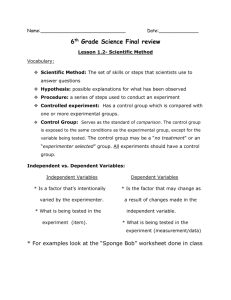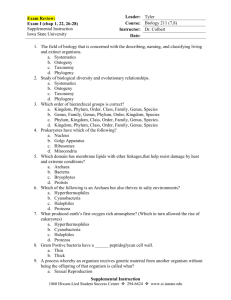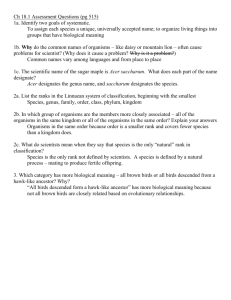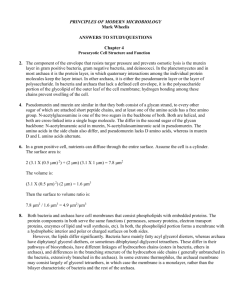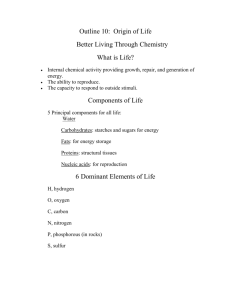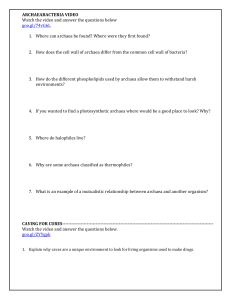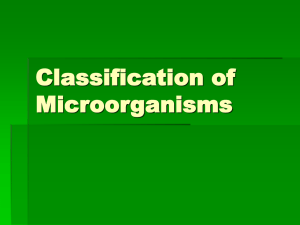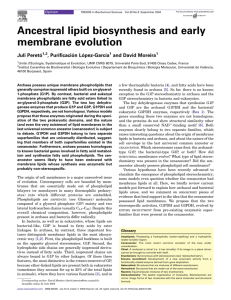Sample Chapter - Wiley-VCH
advertisement
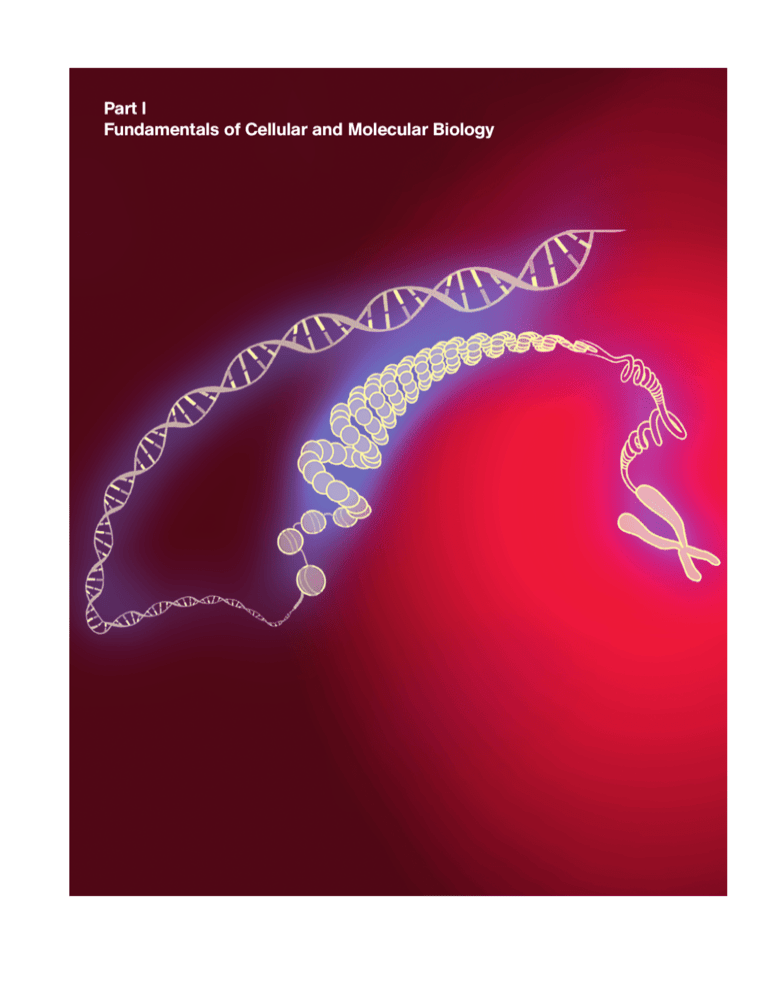
3 1 The Cell as the Basic Unit of Life Learning Objectives This chapter offers a short introduction into the structure of prokaryotic and eukaryotic cells, as well as that of viruses. The base unit of life is the cell. Cells constitute the base element of all prokaryotic cells (cells without a cell nucleus, e.g., Bacteria and Archaea) and eukaryotic cells (or Eukarya) (cells possessing a nucleus, e.g., protozoa, fungi, plants, and animals). Cells are small, membrane-bound units with a diameter of 1–20 lm and are filled with concentrated aqueous solutions. Cells are not created de novo, but possess the ability to copy themselves, meaning that they emerge from the division of a previous cell. This means that all cells, since the beginning of life (around 4 billion years ago), are connected with each other in a continuous lineage. In 1885, the famous cell biologist Virchow conceived the law of omnis cellula e cellulae (all cells arise from cells), which is still valid today. The structure and composition of all cells are very similar due to their shared evolution and phylogeny (Fig. 1.1). Owing to this, it is possible to limit the discussion of the general characteristics of a cell to a few basic types (Fig. 1.2): · Bacterial cells. · Plant cells. · Animal cells. An Introduction to Molecular Biotechnology, 2nd Edition. Edited by Michael Wink Copyright © 2011 WILEY-VCH Verlag GmbH & Co. KGaA, Weinheim ISBN: 978-3-527-32637-2 Fig. 1.1 Tree of life – phylogeny of life domains. Nucleotide sequences from 16S rRNA, amino acid sequences of cytoskeleton proteins, and characteristics of the cell structure were used to reconstruct this phylogenetic tree. Prokaryotes are divided into Bacteria and Archaea. Archaea form a sister group with eukaryotes; they share important characteristics (Tables 1.1 and 1.2). Many monophyletic groups can be recognized within the eukaryotes (diplomonads/trichomonads, Euglenozoa, Alveolata, Stramenopilata (heterokonts), red algae and green algae/plants, fungi and animals; see Tables 6.3–6.5 for details). 4 Fig. 1.2 Schematic structure of prokaryotic and eukaryotic cells. (A) Bacterial cell. (B) Plant mesophyll cell. (C) Animal cell. 1 The Cell as the Basic Unit of Life 1 The Cell as the Basic Unit of Life Character Prokaryotes Eukaryotes Archaea Bacteria Organization Unicellular Unicellular Cytology Internal membranes Compartments Organelles Ribosomes Membrane lipids Rare Only cytoplasm No 70S Ether lipids Always (Table 1.2) Several (Table 1.2) mitochondria; plastids 80S (mt, cp: 70S) Ester lipids, sterols Cell division Genetics Nuclear structure Nucleoid Nucleoid Similar to conjugation Circular, single Rare Rare Yes DNA plasmids (linear) Concomitantly Conjugation Membrane-enclosed nucleus Meiosis, syngamy Cytoskeleton Recombination Chromosome Introns Noncoding DNA Operon Extrachromosomal Transcription/ translation Promotor structure TATA box RNA polymerases Several (8–12 subunits) Transcription factors Yes Initiator tRNA Methionyl-tRNA Cap structure of mRNA polyadenylation No Circular, single Rare Rare Yes Plasmids (circular) Concomitantly –35 and –10 sequences 1 (4 subunits) No (sigma factor) N-formylmethionyltRNA No Table 1.1 Comparison of important biochemical and molecular characteristics of the three domains of life. Unicellular or multicellular Rare Only cytoplasm No 70S Ester lipids, hopanoids Pseudopeptidoglycan, Murein polysaccharides, (peptidoglycan), glycoproteins polysaccharides, proteins FtsZ and MreB FtsZ and MreB protein protein Binary fission Binary fission Cell wall 5 PL: polysaccharides, cellulose F: chitin A: no Tubulin, actin, intermediary filaments Mitosis Linear, several Frequent Frequent No mtDNA, cpDNA, plasmids in fungi Transcription in nucleus; translation in cytoplasm TATA box 3 (with 12–14 subunits) Yes Methionyl-tRNA Yes PL, plants; F, fungi; A, animals; mt, mitochondria; cp, plastid. Fig. 1.3 Schematic structure of bacteriophages and viruses. (A) Bacteriophage T4. (B) Structure of a retrovirus (human immunodeficiency virus causing AIDS). 6 Table 1.2 Compartments of animal and plant cells and their main functions. 1 The Cell as the Basic Unit of Life Compartment Occurrence Functions Animal Plant Nucleus A P Harbors chromosomes; site of replication, transcription, and assembly of ribosomal subunits Endoplasmic reticulum rough ER A smooth ER A Golgi apparatus A P P P Posttranslational modification of proteins Synthesis of lipids and lipophilic substances Posttranslational modification of proteins; modification of sugar chains Harbors hydrolytic enzymes; degrades organelles and macromolecules, macrophages eat invading microbes Sequestration of storage proteins, defense and signal molecules, contains hydrolytic enzymes, degrades organelles and macromolecules Organelle derived from endosymbiotic bacteria; contains circular DNA, own ribosomes; enzymes of citric acid cycle, b-oxidation, and respiratory chain (ATP generation) Organelle derived from endosymbiotic bacteria; contains circular DNA, own ribosomes; chlorophyll and proteins of photosynthesis, enzymes of CO2 fixation and glucose formation (Calvin cycle) Contains enzymes that generate and degrade H2O2 Harbors all compartments, organelles, and the cytoskeleton of a cell; many enzymatic pathways (e.g., glycolysis) occur in the cytoplasm Lysosome A Vacuole Mitochondrium P A Chloroplast Peroxisome Cytoplasm P P A A P P A, animal; P, plant. The most important biochemical and cell biological characters of Archaea, Bacteria, and Eukarya are summarized in Table 1.1. As viruses and bacteriophages (Fig. 1.3) do not have their own metabolism they therefore do not count as organisms in the true sense of the word. They share several macromolecules and structures with cells. Viruses and bacteriophages are dependent on the host cells for reproduction, and therefore their physiology and structure are closely linked to that of the host cell. Eukaryotic cells are characterized by compartments that are enclosed by biomembranes (Table 1.2). As a result of these compartments, the multitude of metabolic reactions can run in a cell at the same time. In the following discussion on the shared characteristics of all cells, the diverse differences that appear in multicellular organisms should not be forgotten. The human body has more than 200 different cell types, which show diverse structures and compositions. These differences must be understood in detail if cell-specific disorders, such as cancer, are to be understood and consequently treated. Before a detailed discussion of cellular structures and their functions (see Chapters 3–5), a short summary of the biochemical basics of cellular and molecular biology is given in Chapter 2.

